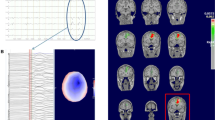Summary
During the last ten years clinical neurophysiology has used computerized quantitative methods for analysis. Evaluation of the information previously hidden in the signals from the nervous system offers previously unknown uses and applications for neurosurgery. The quantitative EEG (QEEG) for example may offer more reliable and easily understandable information of brain activity than the conventional analogue EEG. The techniques for QEEG-analysis have now reached such an advanced stage that they extract at the same time more information from the EEG than can be achieved by visual interpretation. The problems of distances between neurosurgical departments and computer centers can be overcome by means of telephone transmitter systems, as has been done in the present study. Patients with epilepsy or brain tumour undergoing surgery were analyzed and monitored with the peroperative tele-QEEG-system. Our experiences were encouraging since the neurophysiological part of the work at the operation unit was reduced considerably thanks to the telesystem. At the same time we obtained easily understandable EEG-information which has never previously been available to us.
Similar content being viewed by others
References
Grass, A. M., Gibbs, F. A., Fourier transform of the electro-encephalogram. J. Neurophysiol.1 (1938), 521–526.
Hjorth, B., Time domain descriptors and their relation to a particular model for generation of EEG activity. CEAN Konferenz, Frankfurt, 1974.
Ingvar, D. H., Sjölund, B., Ardö, A., Correlation between dominant EEG-frequency, cerebral oxygen uptake and blood flow. Electroenceph. clin. Neurophysiol.41 (1976), 268–276.
Kaiser, E., Petersén, I., Automatic analysis in EEG. 1. Tape computer system for spectral analysis. 2. Reverse correlation. Acta neurol. scand.42 (1966), suppl. 22, 1–38.
Lindgren, G., Spectral moment estimation by means of level crossings. Biometrika61, 3 (1974), 401–418.
Lopes da Silva, F. H. (1976), see Matejcek and Schenk 1976.
Matejcek, M., Schenk, G. K., edit. for proceedings of the 2nd symposium of the study group for EEG-methodology, Jongny sur Vevey, May 1975. Quantitative Analysis of the EEG, Methods and Applications, 1976, p. 610. (AEG-Telefunken, EDP, A-510, D-7750 Konstanz.)
Stigsby, B., Obrist, W. D., Sulg, I. A., Automatic data acquisition and period-amplitude analysis of the EEG. Computer Progr. Biomedic.3 (1973), 93–104.
Sulg, I. A., The quantitated EEG as a measure of brain dysfunction. Scand. J. Clin. Invest.23 (1969), suppl. 109: p. 110.
Zetterberg, L. H., Estimation of parameters for a linear difference equation with application to EEG analysis. Math. Biosci.5 (1969), 227–275.
Author information
Authors and Affiliations
Rights and permissions
About this article
Cite this article
Nyström, S.H.M., Sulg, I. & Hokkanen, E. Multi-channel telephone transmission and quantitative on-line analysis of EEG in brain surgery. Acta neurochir 41, 255–268 (1978). https://doi.org/10.1007/BF01809154
Issue Date:
DOI: https://doi.org/10.1007/BF01809154




